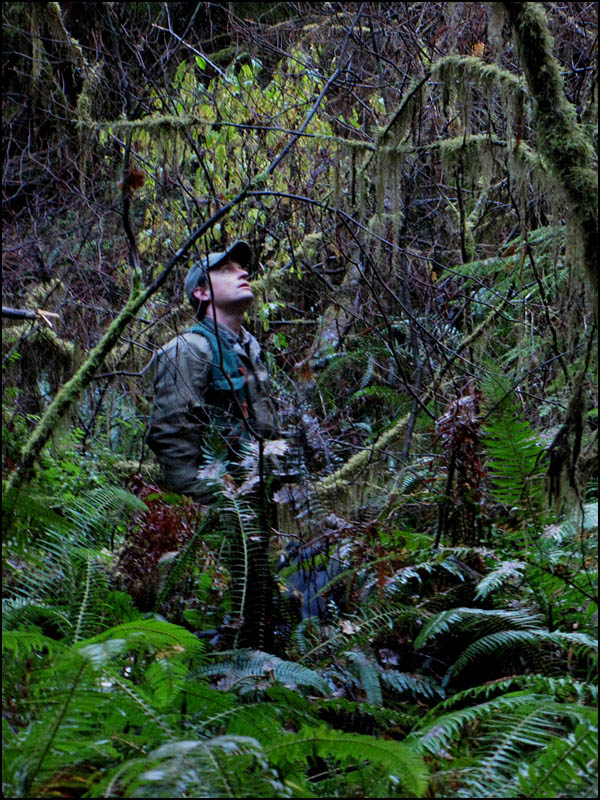Recently, I added a section to my 2014 discoveries page about other redwood explorers of the last 50 years. Here is the infoin a nutshell. The photo is Dr. Steve Sillett of HSU, exploring Jedediah Smith Redwoods
Ron Hildebrant, among the explorer network, goes back years with Michael Taylor. After Dyerville Giant of Humboldt Redwoods SP, fell March 24, 1991, after a strorm, Michael and Ron teamed-up to figure out the height using marks on the adjacent “Cat Scratch” redwood. Dyerville Giant was actually discovered around 1966 by U. of C. scientist Paul Zinke and graduate student Alen Stangenberger.
In February 1993, by phone, it was Zinke who told Michael Taylor to look for his other finds, tagged 12, 13 and 14, or the “Three Peas in a Pod”. Taylor and Hildebrant first became friends around Christmas 1990, and their first expedition together was February 1991 in Humboldt Redwoods SP, searching for tallest redwoods. Between that winter and the next summer is when Taylor began his quest for largest coast redwoods. Prairie Creek Redwoods SP was Taylor’s starting point.
Michael Taylor and Steve Sillett met autumn 1994 after Taylor spotted a super tall coast redwood. When Sillett arrived with a climbing team to measure, he noticed a small #12 tag, meaning it must be one of Zinke’s Peas in the Pod. This is the same redwood they named Telperion, and spent the night in the high canopy during a small rain storm. It fell during another storm 1 or 2 months later. By 1996, Sillett had climbed and confirmed Taylors Mendocino redwood as a new world record for that era; 367.5 ft. And they found others together around the same time, like Pipe Dream in Humboldt Redwoods SP.
1987, Sillett’s exposure to redwoods overlapped enrollment at Reed College. He went camping at Prairie Creek, site of his legendary free-climb of a big redwood with friend Marwood. They used an adjacent redwood’s limbs to 70 feet, then leaped into the big one, and to the top. The same week, Taylor, who had met redwoods, but not Sillett, was 20 miles away on a Redwood National Park tour bus.
In 1996, Sillett was hired to teach at Humboldt State University, and moved to Arcata from Corvallis, Oregon, 3 years after meeting Taylor. Sillett was busy, but able to squeeze in a few hikes with Taylor. Sillet also applied to Redwood National Parks then, to climb and research. That is the time when Redwood National Parks established a permit process for scientists. They had no climbing permit process before. This is where the study climbs of Iluvatar and Atlas redwood initiated. Sillett already knew Robert VanPelt, a long-time explorer of other Pacific NW forests. Sillett taught VanPelt his redwood climbing techniques, and Robert (Bob) joined the Atlas Grove study project. In 1997, Sillett called Taylor, and started teaming with Taylor to explore Redwood National Park on foot for more tallest redwoods. 1998 is the year Sillett and Taylor discovered Lost Monarch, largest for that era.
Near year 2000, Atkins heard about Taylor. They met and teamed-up for many explorations including Helios and Hyperion in 2006, Atkins broke the world record himself, in 2000, with Statosphere Giant in Humboldt Redwoods. Together, they found at least another hundred redwood taller than 350 ft.
We should probably note Paul Zahl, who, in 1963, led a small National Geographic expedition to what later would become Redwood National Park. Finding no world record, he flew back east, but returned shortly, and discovered the Libbey redwood. Zahl seems one of the shortest-lived redwood explorers, but I think the effort deserves attention because much of their looking did not have the present-day trail system to get around. He practically had to bushwhack Redwood Creek. They finally found an old logging road to get into new spots.
Most of these discoverers are named in Forest Giants of the Pacifc Coast, by Robert Van Pelt, or Richard Preston’s non-fiction redwood adventure book. This is part of the network in a nutshell. Check out my review page on Preston’s book because another explorer of a different sort is mentioned: G. F. Beranek


Recent Comments